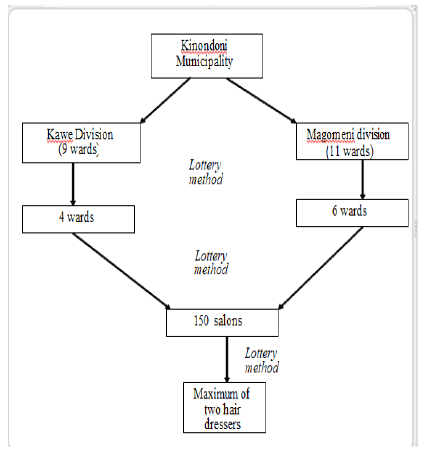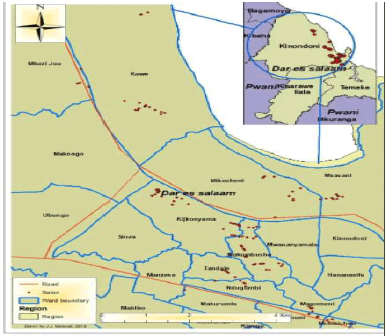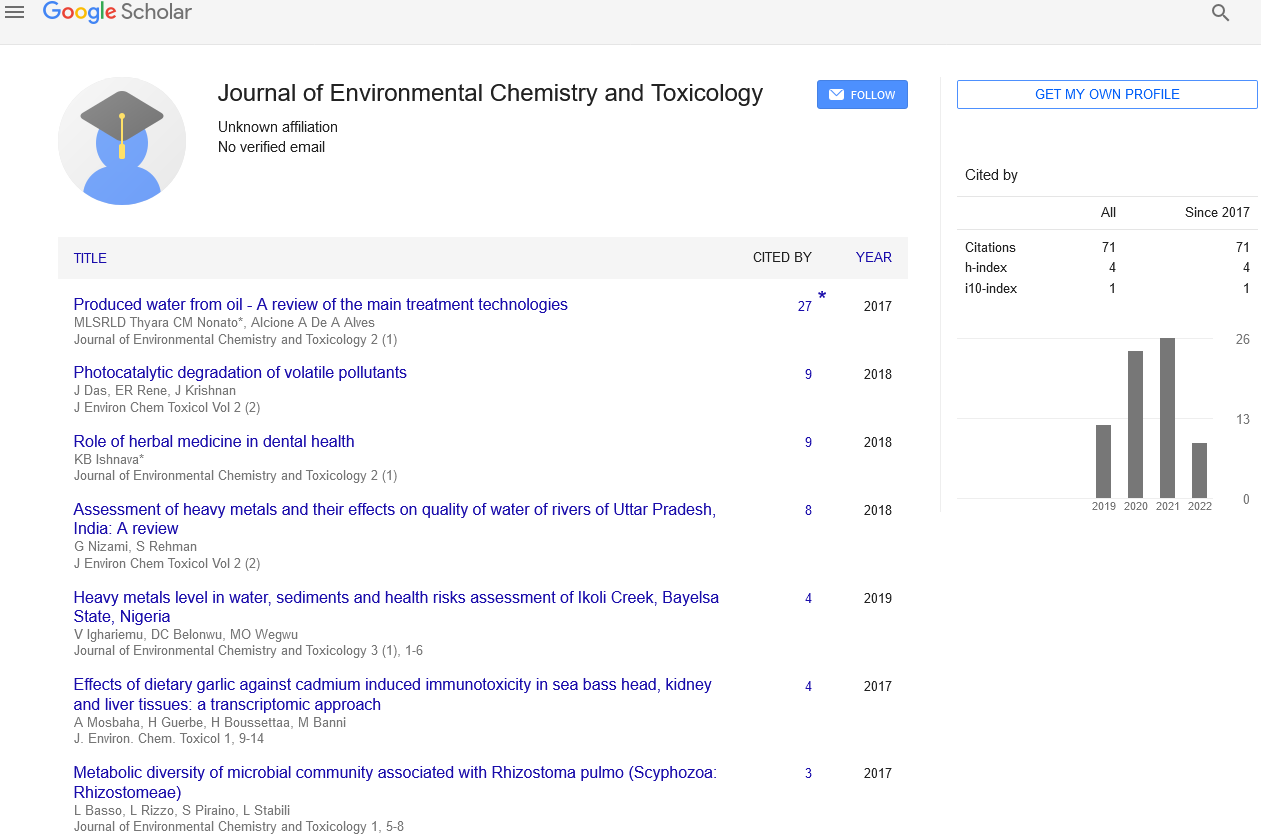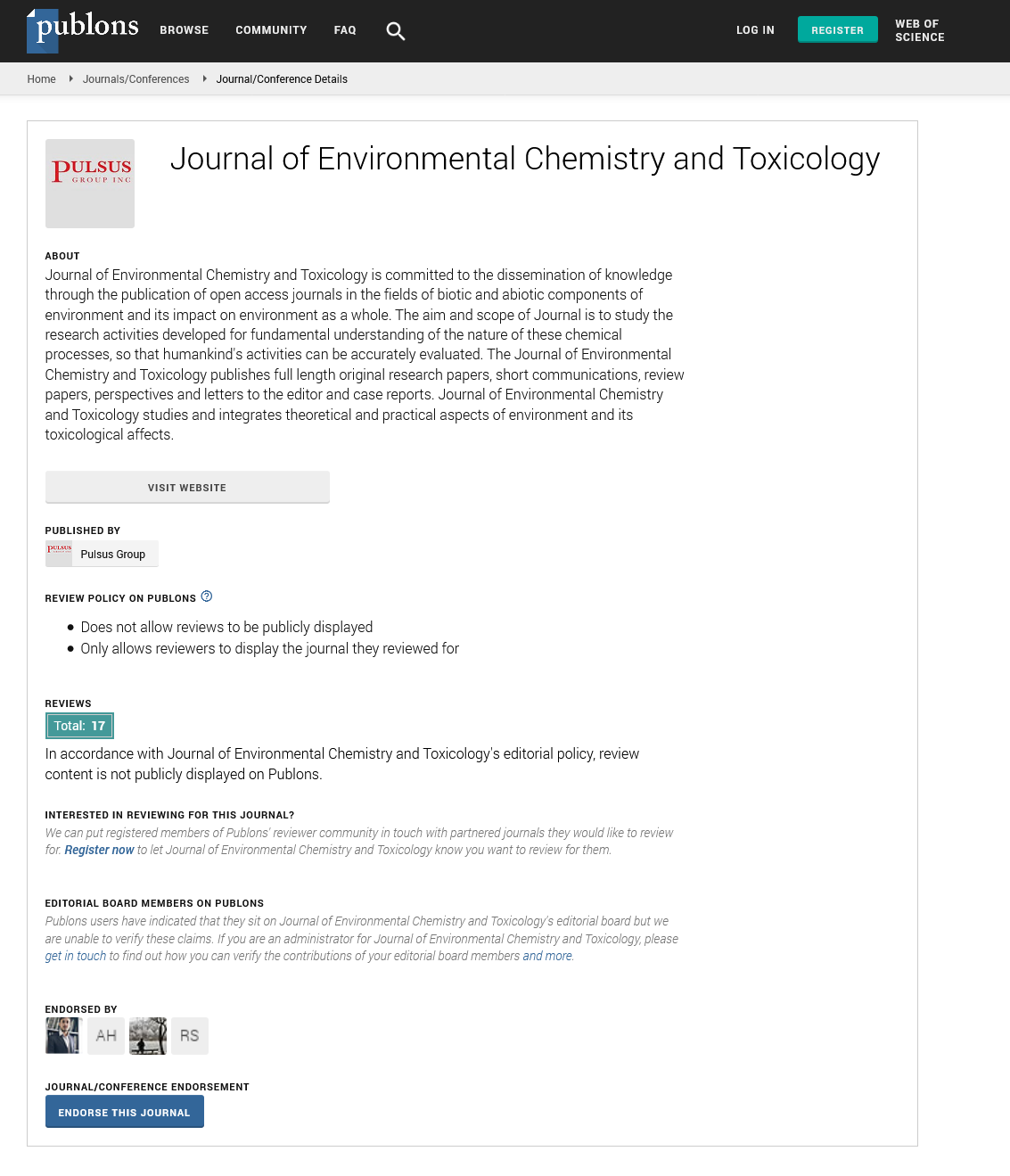Work factors associated with ocular symptoms among hairdressers in Kinondoni municipality, Dar es salaam, Tanzania
Received: 07-May-2022, Manuscript No. PULJECT-22-4920; Editor assigned: 13-May-2022, Pre QC No. PULJECT-22-4920(PQ); Accepted Date: May 24, 2022; Reviewed: 14-May-2022 QC No. PULJECT-22-4920(Q); Revised: 16-May-2022, Manuscript No. PULJECT-22-4920(R); Published: 24-May-2022, DOI: 10.37532/ pulject.2022.6(3);29-33
This open-access article is distributed under the terms of the Creative Commons Attribution Non-Commercial License (CC BY-NC) (http://creativecommons.org/licenses/by-nc/4.0/), which permits reuse, distribution and reproduction of the article, provided that the original work is properly cited and the reuse is restricted to noncommercial purposes. For commercial reuse, contact reprints@pulsus.com
Abstract
Objective: Hairdressers are exposed to chemicals from hair products such as hair dyes, glues, sprays, and relaxants, which increase risks for ocular diseases. The magnitude of ocular symptoms is known to be high. There are limited studies assessing factors associated with ocular diseases among hairdressers in Tanzania. The aim of this study was to determine work factors associated with ocular symptoms among hairdressers in Kinondoni Municipality, Dar es Salaam, Tanzania. Methods: This study employed an analytical cross-sectional study design. Data were collected from 300 hairdressers from 157 salons of Kinondoni Municipality. Data on occupational activities, use of protective equipment, types of hair products used, and selfreported ocular symptoms were gathered by using a structured questionnaire. Chi square test and logistic regression were performed to understand factors associated with ocular symptoms. Results: The study enrolled a total of 300 participants who were primarily female (92%) with the mean age (28 ± 7) years. Ocular symptoms was associated with tasks like hair ironing [AOR= 2.55, 95% CI (1.29-5.06)] and blow drying [AOR= 16.51, 95% CI (4.32-22.01)], hair products including permanent wave [AOR =6.72, 95% CI (1.52-29.63)] and bleach [AOR=8.95, 95% CI (4.03-19.86)]. Gloves, face shield and masks usage was protective against ocular symptoms [AOR= 0.29, 95% CI (0.15 - 0.57)], [AOR=0.17, 95% CI (0.01-0.38)], [AOR=0.23, 95% CI (0.11-0.49)], respectively. Conclusion: Work tasks; hair ironing, blow drying, use of permanent hair wave and bleach were associated with ocular symptoms. Usage of gloves, masks and face shields protected the workers.
Key Words
Ocular Symptoms; Ocular Diseases; Hairdressers ; Salons; Chemicas; Tanzania
Introduction
The hairdressing occupation is associated with exposure to different kinds of health hazards such as chemical, biological, phy- -sical, psychological and ergonomic hazards. The chemicalexposure includes exposure from hair products such as shampoos, permanent wave solutions, dyes, hair sprays, bleach, hair treatmentand relaxants which contain chemicals like ammonium persulphate,glycerylthioglycolate chemicals and hydrogen peroxide chemicals [1,2]. Exposure to these hazards may lead to health problems such asocular diseases, occupational rhinitis, cancer, asthma, fertilityproblems and respiratory diseases [2-5]. In these health problems, thePrevalence of ocular symptoms is reported to be high[6]. Limited studies have been conducted in Tanzania which assess workfactors associated with ocular diseases among hairdressers. The studyconducted by main author in Tanzania reportedindividual/ interpersonal factors associated with ocular symptomsincluding years of work experience, training on chemical use andhazard awareness [6]. Assessment on knowledge of hazards andchemicals in their study showed that, very few hairdressers are trainedon the use of chemicals.
The study also reported that majority of them are not aware of hazards that could harm their health and none knew that they could develop ocular problems due to work Studies among hairdressers show that, hairdressers develop health problems due to lack of awareness on the health impacts of chemicals they are exposed to [7,8]. High prevalence of ocular symptoms among more experienced workers in their study could be due to increased occupational exposure to chemicals. This association is also reported In ocular studies of other occupation such as industrial workers and Singed-hide butchers [9,10]. The Occupational Health and Safety (OHS) Act 2003 is the main legislation governing occupational health and safety practices in Tanzania, but it omits the self-employed and informal sectors like hairdressing [11]. Much of the legislation addresses safety issues such as lifting equipment and steam boilers, and only to some extent covers health issues. The legislation does not incorporate all working population, as it provides OHS services to enterprises that can afford services.
This leaves out informal sectors because of their low income [11]. Given the lack of data from Tanzania, we conducted a study to assess work factors associated with ocular symptoms among hairdressers in Kinondoni Municipal, Dar es Salaam. Such knowledge would be important in preventing chemical hazards in these workplaces.
Research Methodology
Study design
This analytical cross-sectional study was conducted to determine work factors associated with ocular symptoms among hairdressers.
Setting
The study was conducted in Kinondoni Municipality in Dares Salaam region, Tanzania. It has a total area of 522.3 km2 with a population of 1,775,049 (Tanzania Demographic Census 2012). The municipality has two divisions, Magomeni and Kawe, with eleven and nine wards, respectively, from which the study participants were recruited. The Kinondoni Municipality was selected for this study because it has a large number of hairdressing salons (304) compared to other districts.
Study subjects and sampling methodology
The study was conducted from April to June 2018. The method used for sample size estimation was probability sample size estimation developed by [12]. The sampling procedure was a multistage sampling from municipality to division to ward then to salon and finally to hairdresser (Figure 1).
Data collection tools and procedures
A face-to-face interview with hairdressers was conducted using a structured questionnaire that was pre-tested in four hairdressing salons located in Kijitonyama and Msasani wards.
The questionnaire gathered information on socio-demographic characteristics, work activities; use of personal protective equipment (PPE), types of hair products used, and reported ocular symptoms. The questionnaire was written in English and translated into Swahili. A checklist was used torecord the presence and use of PPE (the recommended equipment by Tanzania Occupational Health and Safety Act 2003, such as eye goggles for eye protection, gloves for protection of the hands and masks for protecting the nose). Prior to data collection, research assistants were trained and familiarized with the study objectives and the data collection tools. At each hairdressing salon, we conducted observation and interviewed a maximum of two hairdressers. Data collection was done on weekdays from morning to afternoon hours. Study was restricted to 319 participants who had worked as hairdressers for at least two years. Participation was voluntary. Hairdressers were informed about the purpose of the study and their consent was requested. In order to have a representative sample, two hairdressers were interviewed at each salon; all were between 18 years old and above.
Data Analysis
The dependent variable, ocular symptoms (i.e. blurry vision, headache, burning sensation, painful eye, discharge, tearing), were measured as categorical variables where 1 is the presence of any ocular symptom and 2 was the absence of symptom. The prevalence was reported in the previous study [6]. Independent variables included the use of PPE, occupational activities performed and types of hair products used. Potential confounders such as age, education, ocular condition prior to hairdressing occupation, and conditions such as diabetes and hypertension were controlled for in the multiple logistic regression model.
Statistical analyses
The data was analyzed by using IBM Statistical Package for Social Sciences (SPSS) for Windows version 20 (IBM Corp., Armonk, New York, USA) applying both descriptive and inferential statistical approaches. Inferential statistical approaches applied were chi-square test and logistic regression where p-value less than 0.05 was considered statistically significant. Chi-square test was used to show the relationship between categorical variables (ocular symptoms) and independent variables (type of PPE used, type of work activities performed and type of hair product used). Logistic regression was used to determine factors which affected the outcome variable independently while correcting for confounders (age, education, history of ocular diseases, diabetes and blood pressure).
Ethical Considerations
Ethical approval was obtained from Muhimbili University of Health and Allied Sciences (MUHAS) research and publication committee. The permission to conduct the study at the Kinondoni Municipality was obtained from the District Medical Officer (DMO) of Kinondoni Municipality. Participants were given written informed consent forms before consenting to participate. The study participants who were found to have ocular symptoms were advised to seek health care from the nearest health care facility.
Results
Background characteristics of study participants We contacted 319 hairdressers, of whom 300 from 157 salons (figure 2) participated in the study, resulting in a participation rate of 94%.
Of the selected salons, none had proper ventilation, majority had an open door and circulating fan, very few had air cooling system. The mean age was 28 ± 7 years, and most participants had received either primary or secondary education. Most study participants were nondiabetic and had normal blood pressure. These characteristics have been described elsewhere [6]. Distribution of risk factors In our study, hairdressers self-reported to engage in work activities such as hair washing (100%), hair pruning (100%), blow drying (94.3%), hair ironing (79.3%), hair dyeing (91.7%), hair curling (96.7%), hair relaxing (88.7%), hair steaming (98.7%), hair bleaching (86.7%) and hair conditioning (99.3%). Also, assessment on the use of personal protective equipment showed that, 87 (29%) used face shield, 60 (20%) used masks and 60 (20%) used gloves (Table 1).
TABLE 1 Distribution of risk factors among hairdressers in Kinondoni Municipality (N = 300)
| Factors | Ocular symptoms | ||||
|---|---|---|---|---|---|
| Yes | No | Total | p-value | ||
| n (%) | n (%) | n (%) | |||
| Tasks | |||||
| Hair conditioning | |||||
| Yes | 235(77.6) | 63(22.4) | 298(100) | 0.321 | |
| No | 1(50) | 1(50) | 2(100) | ||
| Hair steaming | |||||
| Yes | 233(78.7) | 63(21.3) | 296(100) | 0.857 | |
| No | 3(75.0) | 1(25) | 4(100) | ||
| Hair ironing | |||||
| Yes | 195(88.9) | 43(18.1) | 238(100) | 0.007 | |
| No | 41(66.1) | 21(33.9) | 62(100) | ||
| Blow drying | |||||
| Yes | 232(82.0) | 51(18.0) | 283(100) | 0.0001 | |
| No | 4(23.5) | 13(76.5) | 17(100) | ||
| Hair products | |||||
| Hair dyes | |||||
| Yes | 220(79.1) | 58(20.9) | 278(100) | 0.480 | |
| No | 16(72.7) | 6(27.3) | 22(100) | ||
| Wave solution | |||||
| Yes | 233(80.3) | 57(19.7) | 290(100) | 0.001 | |
| No | 3(33.3) | 6(66.7) | 9(100) | ||
| Hair bleach | |||||
| Yes | 220(84.6) | 40(15.4) | 260(100) | 0.0001 | |
| No | 16(40) | 24(60) | 40(100) | ||
| Hair relaxants | |||||
| Yes | 236(88.7) | 30(11.3) | 266(100) | 0.0001 | |
| No | 0(0) | 34(100) | 34(100) | ||
| PPE usage | |||||
| Gloves | |||||
| Use | 38(63.3) | 22(36.7) | 60(100) | 0.0001 | |
| Don’t use | 214(89.2) | 26(10.8) | 240(100) | ||
| Face shield | |||||
| Use | 49(56.3) | 38(43.7) | 87(100) | 0.0001 | |
| Don’t use | 187(87.8) | 26(12.2) | 240(100) | ||
| Masks | |||||
| Use | 33(55.0) | 27(45.0) | 60(100) | 0.0001 | |
| Don’t use | 208(86.7) | 32(13.3) | 240(100) | ||
Relationships between ocular symptoms and work factors Prevalence of ocular symptoms among this group is 78.7% [6]. Work factors were independently associated with increased ocular symptoms. Hairdressers who were engaged in tasks like hair ironing and blow drying had increased odds of developing ocular symptoms [AOR= 2.55, 95% CI (1.29-5.06)] and [AOR= 16.51, 95% CI (4.32- 22.01)] respectively compared to those who did not. When the magnitude of effect was measured against hair products; handling permanent wave and hair bleach had increased odds ratio for developing ocular symptoms [AOR =6.72, 95% CI (1.52-29.63)] and [AOR =8.95, 95% CI (4.03-19.86)] respectively. Use of Personal Protective Equipment (PPE) such as gloves, face shield and masks gave a considerable protection against development of ocular symptoms [AOR = 0.29, 95% CI (0.15 - 0.57)], [AOR = 0.17, 95% CI (0.01 - 0.38)] and [AOR = 0.23, 95% CI (0.11 - 0.49)] respectively (Table 2).
TABLE 2 Work factors associated with ocular symptoms
| Crude OR | Adjusted OR | |||
| OR (95%CI) | p-value | OR (95%CI) | p-value | |
| Activities | ||||
| Hair ironing | ||||
| Yes | 2.32(1.25-4.32) | 0.001 | 2.55(1.29-5.06) | 0.007 |
| No | Reference | Reference | ||
| Blow drying | ||||
| Yes | 14.78(4.63-47.2) | 0.0001 | 16.51(4.32-22.01) | 0.01 |
| No | Reference | Reference | ||
| Hair products | ||||
| Permanent wave | ||||
| Yes | 8.03(1.95-33.09) | 0.001 | 6.72(1.52-29.63) | 0.012 |
| No | Reference | Reference | ||
| Hair bleach | ||||
| Yes | 8.25(4.02-16.89) | 0.0001 | 8.95(4.03-19.86) | 0.01 |
| No | Reference | Reference | ||
| Hair relaxant | ||||
| Yes | 2.13(1.64 - 2.77) | 0.0001 | 1 | 0.969 |
| No | Reference | Reference | ||
| Use of PPE | ||||
| The use of gloves | ||||
| Yes | 0.18(0.01 - 0.32) | 0.0001 | 0.29(0.15 - 0.57) | 0.0001 |
| No | Reference | Reference | ||
| The use of face shield | ||||
| Yes | 0.18(0.1 - 0.32) | 0.0001 | 0.17(0.01 - 0.38) | 0.0001 |
| No | Reference | Reference | ||
| The use of masks | ||||
| Yes | 0.16(0.08 - 0.30) | 0.0001 | 0.23(0.11 - 0.49) | 0.0001 |
| No | Reference | Reference | ||
| The analysis was adjusted for age, diabetes, hypertension, education status and ocular condition prior to hairdressing occupation | ||||
Discussion
In this study, we assessed work factors associated with ocular symptoms among hairdressers in Kinondoni Municipal, Dar es Salaam. The previous study reported higher prevalence of ocular symptoms among this occupation group [6]. In the current study, the symptoms were associated with activities such as hair ironing and blow drying, the use of hair products including permanent wave and hair bleach. Use of personal protective equipment such as gloves, face shield and masks protected the workers from development of symptoms.
Our study had strength and limitations. The variables in this study were self-reported by participants, meaning that they could have been over-reported or under-reported. In addition, the hairdressers may have felt the need to underreport symptoms or deny having ocular problems because they liked their work. Finally, the data were collected in only two divisions of one municipality in Tanzania, and so the results may not be generalizable beyond this area or outside of Tanzania. The strength of this study is in the fact that selection of saloons and sampling of participant was random and it covered a wide area (figure 2).
Participants were given ample time to answer question during the interview. There were also follow up question to ensure they had reported what was experienced. previous studies have focused on ocular symptoms in other occupations [5,10]. We focused on ocular symptoms among hairdressers. Various studies have addressed occupational health issues among hairdressers [1-3,5], but ocular issues were limited in these studies. Others have focused on assessment of predictors for ocular diseases in other occupations [5,10]. Our study assessed predictors for ocular symptoms among hairdressers.
We observed higher odds of ocular symptoms and tasks like blow drying and hair ironing. This association might be due to the heat produced from the driers and irons that could lead to rapid falling of tears from the eyes. This implication was also seen in the study done in Ghana that hairdressers are exposed to heat from the driers and hair irons that could trigger rapid tearing and causes dry eyes [4]. This effect was also indicated in the studies done elsewhere [13,14]. The higher odds of ocular symptoms observed when using hair products (bleach and permanent wave) might be due to the chemical ingredients they contain. Studies show that bleach and permanent wave contain volatile chemicals that could cause significant health problems including ocular conditions [4]. A study done in Italy showed that hair bleach consists of persulfate chemical in both gaseous and particle forms emitted during mixing and application which act as allergens and eye irritants [15] Hair bleaching powder was also reported in a study done in 2010 as the most irritating chemical for eyes and respiratory tract and that it was the most aggravating hair product to eye and respiratory problems [16]. Additionally, in a study that was done in 2016, it was reported that hair bleach contained ammonium persulphate and glycerylthioglycolate chemicals and hydrogen peroxide chemicals in permanent wave that caused significant ocular irritation[8]. The observed effect of such hair products in our study is not surprising because we observed the same chemical contents in some of the hair products used in the selected salons particularly hair bleach and permanent wave. Therefore, this significant association could be probably due to the same chemicals evidenced to cause the symptoms. A Review that was done in 2015 in Kenya on practices and products used for hairdressing occupation revealed that majority of the hair products used in salon can cause significant eye damage if not used with precaution [17].
The use of PPE protected hairdressers from developing ocular symptoms. Failure to use any protective equipment among hairdressers has been reported to be significant associated with ocular conditions [4]. In other occupations, the use of personal protective equipment in general is reported to be poor [11,13,18]. With this case, efforts are called upon to enhance occupational health and safety promotion to encourage and enforce the use of protective measures. Though the study did not investigate the reasons for not wearing personal protective devices, studies suggest reasons such as unavailability, cost, interference with the work, poor perception and attitudes towards the use [18-20]. our study did not asses health ocular condition/disease severity and hairdressers’ health seeking behavior. Future studies should build on these findings by assessing health seeking behavior among this group of occupation as well as measuring ocular diseases and their severity.
Conclusion
Hair ironing and blow-drying, working with permanent hair waves and bleaches, low utilization of protective equipment are associated with ocular symptoms in this population. We recommend hairdressers to use protective gears to protect themselves from occupational exposures that could lead to ocular symptoms and other health effects.
• Hairdressers are exposed to chemical hazards that may lead to potential health impacts including ocular condition;
• The magnitude of ocular symptoms among hairdressers is high;
• Work-related ocular symptoms can lead to loss of sight.
What this study adds.
• Work factors that contribute to ocular symptoms are now known;
• Hair bleach, permanent wave, blow drying and hair ironing are the most predictors for hairdressers to experience ocular symptoms;
• Proper use of PPE like masks, gloves and face shield are protective against ocular symptoms
Acknowledgement
We acknowledge Dr. Vera Ngowi for her support towards accomplishment of this study. The authors are grateful for the financial support provided by NORAD through the NORHEDprogramme (Norwegian Programme for Capacity Development in Higher Education and Research for Development) via NORHED Project Tan:1300646-12 (North-South-South collaboration). We would also like to thank hair dressers of Kinondoni Municipality who spared their precious time to participate in our study.
Conflict of Interests
Authors declared they have no conflicts of interest. Authors' contributions Baldwina Tita Olirk coordinated the study, designed the questionnaire, conducted field investigations and performed the statistical analysis and writing of the paper. She is the main author of the manuscript. Ezra Jonathan Mrema contributed to the formulation of the study, participated in data collection and writing of the manuscript. Simon Henry Mamuya contributed to the inception of the study, data analysis and writing of the paper. William Nelson contributed in the data analysis and writing of the manuscript. All authors read and approved the final manuscript.
REFERENCES
- Tsigonia A, Lagoudi A, Chandrinou S et al. Indoor air in beauty salons and occupational health exposure of cosmetologists to chemical substances. Int J Environ Res Public health 2010;7(1):314-324.
Googlescholar Crossref - Kim D, Kang MY, Choi Set al. Reproductive disorders among cosmetologists and hairdressers: a meta-analysis. Int Arch Occup Environ Health. 2016;89(5):739-753.
Google scholar Crossref - Ferreira AP. An assessment of occupational health risks in female hairdressers forefront to xenobiotics. Env Occup Sci. 2013;94(3):190-198.
Googlescholar - Kumah DB, Abdul-Kabir M, Aidoo F. et al. Prevalence of Ocular Conditions among Hairdressers in the Kumasi Metropolis, Ghana. BAOJ Ophthalmol.;1(011).
Googlescholar - Johansson Gabriella, Jönsson Bo, Axmon Anna et al. Exposure of hairdressers to ortho- and meta-toluidine in hair dyes. Occup Env Med. 2014;72:57–63.
- Olirk Baldwina, Mrema Ezra, Mamuya Simon. Ocular symptoms and associated factors among hairdressers in Kinondoni Municipality , Dar es Salaam , Tanzania. EAJAHME. 2020;4:22-27
- Kingsley Ethinnah, Joseph Agbi, Orevaoghene Akpovieneh et al. Occupational hand dermatitis among hairdressers in a semi-urban community in Nigeria. Niger Health J. 2013;13:125–130
Googlescholar - Bigambo Francis, Saria Josephat. Occupational Health Risks Among Cosmetologist : A Case Of Kinondoni Municiparity Dar Es Salaam , Tanzania. J Multidiscip Eng Sci Stud. 2016;2:766–73
Googlescholar - Parulekar Paul, Naik Perni, Vaz Frederick. Prevalence of ocular morbidity amongst industrial workers in Goa, India. Int J Recent Adv Multidiscip Res. 2015; 2:298– 300.
Googlescholar - Kumah David, Abdul–Kabir Mohammed et al. Ocular conditions among singed – hide butchers at The Kumasi abattoir. Epidemiol Res. 2016;2:1–24
Googlescholar Crossref - Mrema Ezra, Ngowi Aiwerasia, Mamuya Simon. Status of Occupational Health and Safety and Related Challenges in Expanding Economy of Tanzania. Ann Glob Health. 2015;81:538–547.
Googlescholar Crossref - Fox Nick, MathersNigel , Hunn Amanda. Sampling and Sample Size Calculation Authors. National institute for Health Reasrch.
Googlescholar - Indoor air in beauty salons and occupational health exposure of cosmetologists to chemical substances
- Gayton Johnny. Etiology, prevalence, and treatment of dry eye disease. Clin Ophthalmol. 2009;3:405–12
Googlescholar Crossref - Nilsson Patrik , Marini Sara, Wierzbicka Aneta et al. Characterization of Hairdresser Exposure to Airborne Particles during Hair Bleaching. Ann Occup Hyg. 2015;60:90–100. Nelson W 6. J Environ Chem Toxicol.2022; 6 (3)
Googlescholar Crossref - Hashemi Nastran, Boskabady Mohammad, Nazari Ashraf. Occupational exposures and obstructive lung disease: A case-control study in hairdressers. Respir Care. 2010;55:895–900
Googlescholar Crossref - Borrie WT, Gale T, Bosak K. Privately protected areas in increasingly turbulent social contexts: strategic roles, extent, and governance. J Sustain Tour.2020 Nov 11:1-8.
Googlescholar Crossref - Abu EK, Boadi-Kusi SB, Opuni PQ et al. Ocular health andsafety assessment among mechanics of the Cape Coast Metropolis, Ghana. J Ophthalmic Vis Res. 2016; 11(1):78.
Google scholar Crossref - Omoti Alir, and Enock Waziri. Ocular disorders in a petroleum industry in Nigeria. Eye Lond. 2008;22:925–929
Google scholar Crossref - Robinson Erin, Arcury Thomas. Eye Health and Safety Among Latino Farmworkers.J Agromedicine.2011;16:143–145
Googlescholar Crossref








